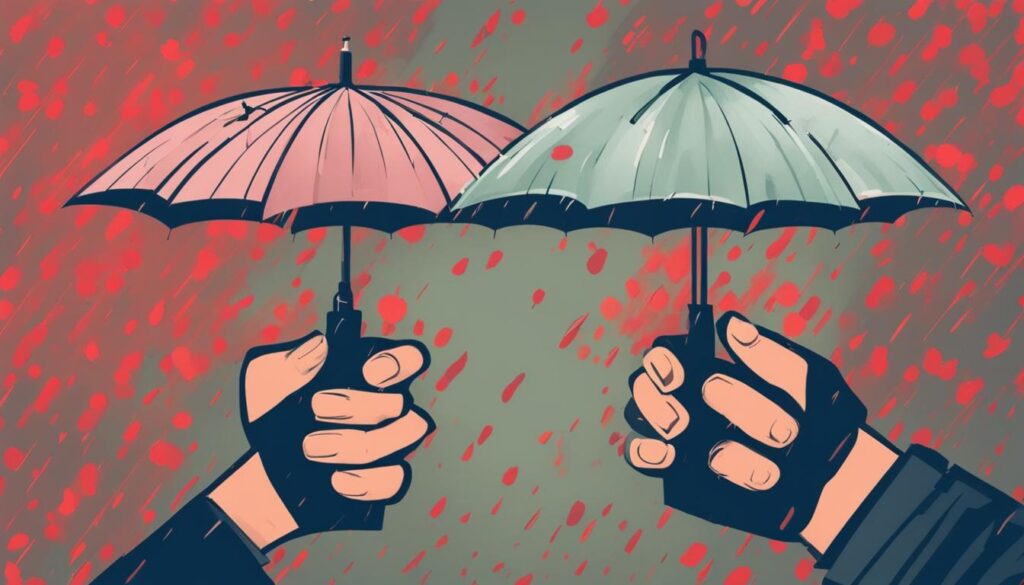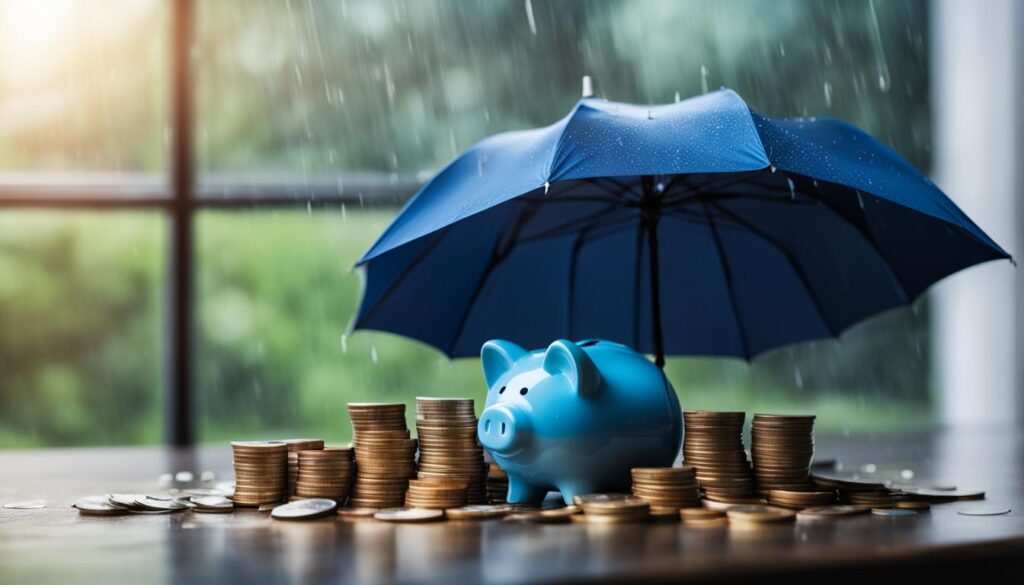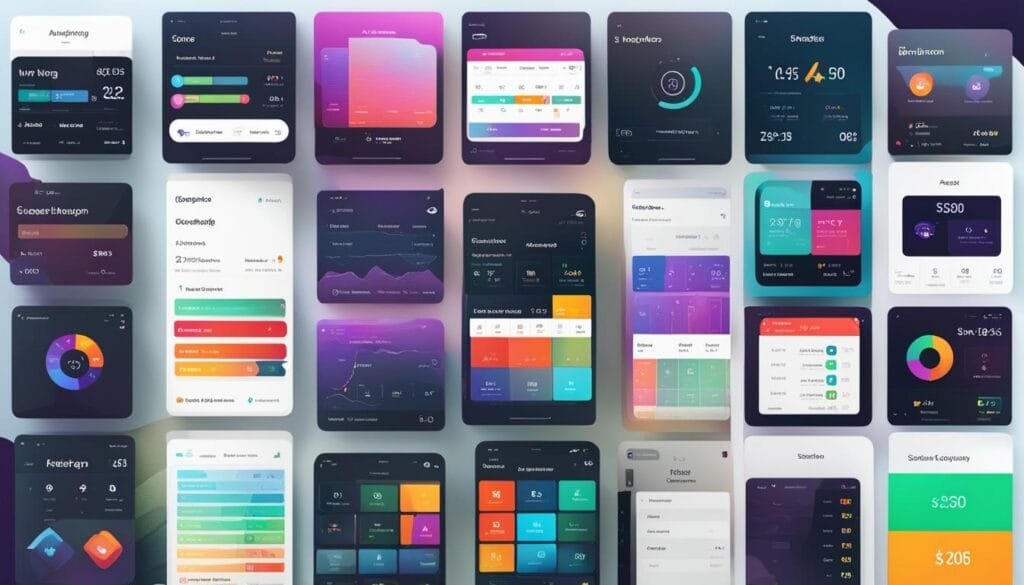When it comes to financial stability, having emergency funds is essential. Life is full of unexpected expenses, and without a safety net, these can quickly derail your financial well-being. That’s why budgeting for emergency funds is a crucial step in securing your financial future.
A recent report from the Federal Reserve Board revealed that 32% of adults would struggle to cover a $400 emergency expense. This alarming statistic highlights the importance of having emergency savings in place. By proactively planning for unexpected expenses, you can protect yourself from financial hardship and maintain peace of mind.
So, how can you ensure that you are prepared for rainy days? In this article, we will explore the concept of a rainy day fund, where to keep your emergency funds, the difference between a rainy day fund and an emergency fund, and strategies to boost your rainy day savings. Let’s dive in!
Key Takeaways:
- Budgeting for emergency funds is crucial for financial safety and stability.
- Having an emergency savings account can protect you from unexpected expenses.
- A rainy day fund is different from an emergency fund, serving to cover smaller, expected expenses.
- Consider high-yield savings accounts and cash management accounts for storing your rainy day funds.
- Boost your rainy day savings by setting savings goals and exploring additional income opportunities.
What is a Rainy Day Fund?
A rainy day fund is a crucial financial safety net that everyone should have. It is a savings account specifically set aside for expected, occasional expenses that are not accounted for in your monthly budget. These can include minor car repairs, routine medical expenses, and home maintenance. By having a rainy day fund, you can easily cover these unexpected expenses without having to dip into your regular savings or rely on credit cards.
One of the best ways to manage your rainy day fund is by keeping it in a high-yield savings account. These types of accounts offer higher interest rates compared to traditional savings accounts, allowing your savings to grow even faster. Plus, they provide easy access to your money whenever you need it. Some popular high-yield savings accounts include SoFi Money, Marcus by Goldman Sachs, and Ally Bank.
Having a rainy day fund not only provides you with peace of mind, but it also helps you stay financially stable in the face of unexpected expenses. By proactively saving for these expected expenses, you can ensure that your budget remains intact and that your long-term financial goals are not impacted. So start building your rainy day fund today and be prepared for any financial rainy days that may come your way.
Where to Keep Your Rainy Day Funds
When it comes to storing your rainy day funds, there are several options to consider. One popular choice is high-yield savings accounts, which offer higher interest rates compared to traditional savings accounts. These accounts allow your savings to grow over time, providing you with a better return on your investment.
Some high-yield savings account options include SoFi Checking and Savings, Citizens Access Savings, CIT Bank Platinum Savings, and BMO Alto Online Savings Account. Each of these accounts offers competitive interest rates and user-friendly features to help you manage your rainy day funds effectively.
Another option to consider is a cash management account. These accounts provide a combination of a checking account and a savings account, allowing you to easily access your funds while earning interest. Cash management accounts like Wealthfront Cash Account and Betterment Everyday Cash Reserve offer attractive interest rates and additional benefits such as ATM fee reimbursements and FDIC insurance.
If you’re looking for a more long-term savings option, certificates of deposit (CDs) can be a viable choice. CDs allow you to invest your funds for a fixed period of time and earn a higher interest rate. While your money is locked in, you have the peace of mind knowing that your funds are steadily growing. Financial institutions such as Ally Bank and Discover Bank offer various CD options with different terms and interest rates.
| Savings Account | Interest Rate | Additional Benefits |
|---|---|---|
| SoFi Checking and Savings | Up to 0.25% | No account fees |
| Citizens Access Savings | Up to 0.40% | No minimum balance requirement |
| CIT Bank Platinum Savings | Up to 0.45% | No monthly maintenance fee |
| BMO Alto Online Savings Account | Up to 0.20% | No monthly fee |
Choosing the right option for your rainy day funds depends on your financial goals and preferences. Consider the accessibility, interest rates, and additional benefits offered by each account. By selecting a reliable and suitable account, you can confidently build and grow your rainy day funds, ensuring you’re prepared for any unexpected expenses that may arise.
Rainy Day Fund vs. Emergency Fund: What’s the Difference?
A rainy day fund and an emergency fund serve different purposes in our financial lives. While both are important for our financial stability, understanding the differences between them can help us prioritize our savings goals and be better prepared for unexpected expenses and emergencies.
A rainy day fund is specifically for expected expenses that are smaller and more routine in nature. These are expenses that we can anticipate and plan for, like car repairs, home maintenance, or medical co-pays. By setting aside money in a rainy day fund, we can cover these costs without disrupting our monthly budget or dipping into our long-term savings.
An emergency fund, on the other hand, is for larger, unexpected expenses that can have a significant impact on our financial stability. These are expenses that we cannot predict or plan for in advance, such as job loss, a major medical expense, or a home repair due to a natural disaster. An emergency fund provides a financial safety net during times of crisis and helps us avoid going into debt or having to rely on high-interest loans.
Rainy Day Fund vs. Emergency Fund: A Comparison
| Rainy Day Fund | Emergency Fund |
|---|---|
| Meant to cover expected, routine expenses | Meant to cover unexpected, larger expenses |
| Smaller in size compared to an emergency fund | Requires a larger amount of savings |
| Helps maintain monthly budget stability | Provides a financial safety net during crisis |
| Used for expenses like car repairs, home maintenance, or medical co-pays | Used for expenses like job loss, major medical expenses, or home repairs due to natural disasters |
By having both a rainy day fund and an emergency fund, we can be better prepared for unexpected expenses and emergencies of different magnitudes. It’s important to assess our financial situation, set realistic savings goals, and consistently contribute to both funds to ensure our long-term financial stability.

Rainy Day Savings Strategies
When it comes to building your rainy day savings, there are several strategies you can implement to ensure you are prepared for anticipated expenses and unexpected emergencies. By taking proactive steps and utilizing the right tools, you can achieve your savings goals and establish a solid financial safety net.
Prioritize Anticipated Expenses
Start by creating a list of anticipated future expenses, such as car repairs, medical bills, or home maintenance. By identifying these financial obligations in advance, you can allocate funds specifically for these purposes. This approach enables you to proactively save for known expenses and prevents you from dipping into your emergency fund unnecessarily.
Utilize Multiple Savings Accounts
Organize your rainy day savings by using multiple savings accounts or subaccounts dedicated to different goals. This allows you to clearly track your progress towards each objective and ensures that your funds are allocated appropriately. For example, you could have one account for car repairs, another for medical expenses, and a separate one for home maintenance. This segregation of funds helps you stay organized and prevents any confusion about your savings priorities.
Automate Your Savings with Direct Deposits
Consider setting up direct deposits from your paycheck to automate your savings. By instructing your employer to deposit a portion of your earnings directly into your rainy day savings account, you are less likely to miss or spend that money. This strategy helps you build your savings effortlessly and consistently, making it easier to achieve your financial goals over time.

Implementing these rainy day savings strategies can significantly strengthen your financial preparedness. By prioritizing anticipated expenses, utilizing multiple savings accounts, and automating your savings with direct deposits, you can establish a robust financial safety net and protect yourself from unexpected financial setbacks.
Boosting Your Rainy Day Savings
When it comes to building up your rainy day savings, there are several strategies you can implement to make the most of your efforts. By incorporating these savings strategies into your financial routine, you can boost your rainy day fund and be better prepared for unexpected expenses.
“Savings strategies are essential for long-term financial stability.” – Financial expert
One effective strategy is to choose high-yield savings accounts that offer higher interest rates on your savings. These accounts allow your money to grow faster, giving you a better return on your investment. Look for banks or financial institutions that provide competitive rates, and consider options like online banks or credit unions that might have lower fees and better rates than traditional banks.
Another way to boost your rainy day savings is by using cashback debit cards. These cards allow you to earn rewards on your everyday purchases, and you can direct the cashback to your savings account. It’s like earning free money while you spend, helping you add extra funds to your rainy day savings without any additional effort.
Side hustles: An Extra Stream of Income
If you’re looking for ways to accelerate your savings, consider exploring side hustles. Side hustles are additional jobs or sources of income outside of your primary employment. They can range from freelance work to part-time gigs, such as tutoring, pet sitting, or selling handmade crafts online. By dedicating some of your spare time to a side hustle, you can generate extra money to contribute to your rainy day fund, boosting your savings even faster.
Remember, building a rainy day fund takes time and consistent effort. By implementing these savings strategies and exploring additional ways to increase your income, you can enhance your financial stability and be better prepared for any unexpected expenses that may arise.
Conclusion
Budgeting for emergency funds and creating a rainy day fund are crucial steps in maintaining financial stability. By anticipating expected expenses and preparing for unexpected emergencies, you can safeguard your future and keep your financial well-being intact, even during tough times.
A rainy day fund is specifically designed to cover smaller, more routine expenses that fall outside of your monthly budget. These can include minor car repairs, routine medical expenses, or unexpected home maintenance. It acts as a safety net, allowing you to handle these anticipated expenses without any financial stress.
On the other hand, an emergency fund is tailored to handle larger, unforeseen expenses that can significantly impact your financial stability. Whether it’s a job loss or major medical expenses, having a well-funded emergency fund provides you with peace of mind and the ability to navigate these challenging situations.
To effectively build your rainy day savings, take the time to make a list of anticipated future expenses and set achievable savings goals. Consider using multiple savings accounts or subaccounts to organize your funds and make tracking your progress easier. Automating your savings by setting up direct deposits from your paycheck can also help you consistently contribute to your rainy day fund.
Remember, boosting your rainy day savings is an ongoing process. Look for high-yield savings accounts that offer competitive interest rates to make the most out of your savings. Explore options like cashback debit cards that allow you to earn rewards that can be directly allocated towards your rainy day fund. Additionally, consider pursuing side hustles to generate extra income that can be put towards your emergency savings.
In conclusion, prioritizing budgeting for emergency funds and creating a rainy day fund are essential for maintaining financial stability. By staying proactive, preparing for both expected and unexpected expenses, you can ensure that you’re well-prepared for any financial challenges that come your way.
FAQ
What is a rainy day fund?
A rainy day fund is savings set aside for expected, occasional expenses that are not accounted for in your monthly budget. These can include minor car repairs, routine medical expenses, and home maintenance.
Where should I keep my rainy day funds?
High-yield savings accounts, cash management accounts, and certificates of deposit (CDs) are all options to consider for your rainy day funds.
What is the difference between a rainy day fund and an emergency fund?
Rainy day funds are for expected expenses that are smaller and more routine, such as car repairs or home maintenance. Emergency funds, on the other hand, are for larger, unexpected expenses that can have a significant impact on your financial stability, such as job loss or major medical expenses.
How can I build my rainy day savings?
To build your rainy day savings, make a list of anticipated future expenses and set savings goals. Use multiple savings accounts or subaccounts to organize your funds. Consider automating your savings by setting up direct deposits from your paycheck.
How can I boost my rainy day savings?
You can boost your rainy day savings by choosing high-yield savings accounts with higher interest rates. Consider using cashback debit cards to earn rewards that can be directed towards your savings. Additionally, look for side hustle opportunities to earn extra money to contribute to your rainy day fund.
Why is budgeting for emergency funds important?
Budgeting for emergency funds and creating a rainy day fund is essential for maintaining financial stability. By anticipating expected expenses and preparing for unexpected emergencies, you can safeguard your future and keep your financial stability intact, even during tough times.
Can the Budgeting Techniques for Emergency Funds Also be Applied for Holiday Budgeting?
When it comes to budgeting for the holidays, can we use the same techniques as emergency funds? It’s worth considering. Just like planning for unexpected expenses, setting aside money in advance for gifts, decorations, and travel can help us avoid financial stress during the holiday season. By prioritizing and allocating funds accordingly, we can create a balanced holiday budget. Additionally, treating holiday expenses similarly to an emergency fund for vacations can empower us to enjoy the season without the anxiety of overspending. By determining how much we realistically need for different holiday expenditures and saving systematically throughout the year, we can ensure that we have adequate resources when the festivities arrive. This proactive approach not only alleviates financial strain but also allows us to fully embrace the joy and spirit of the holidays.


Pingback: Fun on a Budget: Entertainment That Won’t Break the Bank – Straight Fire Money